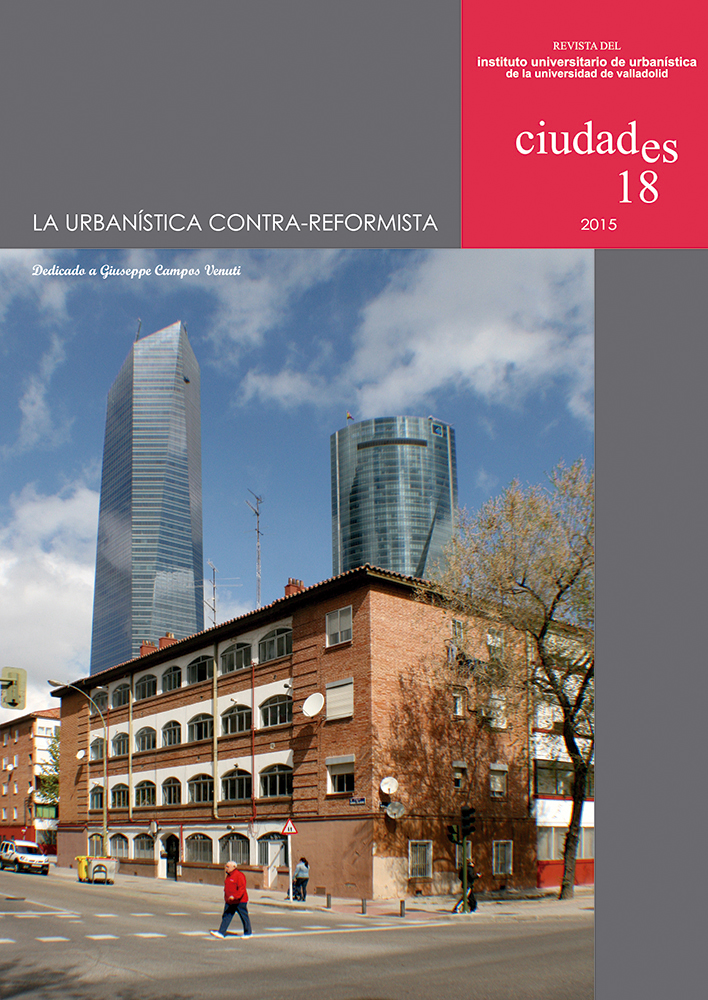The Counter-reformist Urbanism
Ciudades 18, 2015
MONOGRAPH DOSSIER
Álvaro SEVILLA BUITRAGO
Urbanismo, crisis y austeridad
Fernando ROCH PEÑA
Revolución neoliberal y “utopía” ciudadana, una batalla inaplazable
José FARIÑA TOJO
Cambiar el modelo urbano
Ion MARTÍNEZ LOREA
Nuevas privatopías urbanas. Estrategias ciudadanistas del espacio público
Fernando GAJA i DÍAZ
Urbanismo concesional. Modernización, privatización y cambio de hegemonía en la acción urbana
Federico OLIVA
L’urbanistica italiana tra riforma e contrariforma
Stefano GARANO
L’urbanistica riformista nella complessa situazione italiana
Daniel MORCILLO ÁLVAREZ
Inversión, infraestructuras e imagen en la producción del espacio de centralidad en Madrid
Jean-Pierre GARNIER
Urbanismo y neoliberalismo en Francia: una regresión interminable
Ernesto LÓPEZ MORALES
Suelo urbano y segregación residencial: hacia una agenda de integración social para zonas centrales metropolitanas chilenas.
MISCELLANEA
José CARPIO PINEDO y Patxi J. LAMÍQUIZ DAUDÉN
Proximidad del comercio e indicadores de accesibilidad: aplicación a la planificación y regulación en el marco normativo actual
Roberto FERNÁNDEZ
Información versus corporalidad. El colapso del espacio público
FINAL SECTION
of letters, reviews and references on urban
Miguel FERNÁNDEZ MAROTO
El Plan General de Valladolid de 1984. En los orígenes de un nuevo modelo urbano
The truth is that if each individual took and brought to an end the good he is capable of and provided it to the country’s common wellbeing, cities would experiment less disgraces and forth they would reach prosperity”.
«Phoenician women», Euripides, 411 BC.
We live times where those principles that oriented the so called “Reformist Urbanism” are falling in disuse, giving way, precisely, to the politic-administrative practices to which that reform faced against. It could be said that we assist to an authentic “counter-reform”, which is dismissing the urban assumptions born under the support of the rationality developed, back in the 1960’s, first in Italy, and then extended to the rest of Europe, especially in Spain. We refer, among others, to the contributions that, in this sense, were framed in the urban task, both in its projecting and administrative aspects, developed by Campos Venuti, from its implications with municipal administrations in Emilia Romagna.
The principles of “Reformist Urbanism” have been exposed and verified in multiple occasions. The common factor of them all is the plan for a balanced urban development, obtaining real alternatives to the “land’s rent urban model”, providing the establishment of an opportunity equity for every citizen. This equity would materialize in universal access to urban services. For such, at least, two conditions should take place: availability of public land where to locate and materialize them, even as a cession of it as a proportional part to take from those private properties which take benefit from urban decisions taken by local administrations, or as an expropriatory decision. The aim is, after all, to guarantee the public in the city, establishing, for it, the responsibilities in which local administrations and private urban agents should incur.
Let’s remember, in this sense, the discussion held by Campos Venuti with certain left-wing politic formations during the redaction of the last Plan for the city of Rome. In an allegation sent to this city’s Mayor, back in year 2003, entitled «To avoid the Urban Counter-reform for the Regulating Plan of Rome», Campos Venuti pointed the finger at those who transform the expropriation procedure into the main instrument for the Plan management.
The controversy is already set, and with it one of the matters to develop in Monographic Dossier of this issue of «Ciudades»: does land property, held by the municipality by the expropriation, guarantee the start-up of urban policies tending to enhance the public in the city? Is it possible to ensure this guarantee through those other procedures which canalize this availability with mandatory cessions coming from urban agents, even owners or promoters? Independently of the management procedure, the attitude facing the ways of proceeding to enforce the equity that must characterize “Reformist Urbanism” should be clear.
From Campus Venuti`s viewpoint, in effect, the expropriation support would mean to accept its paralyzing effects, as municipalities should count on budgets difficult to manage within the current economic situation in order to proceed to that one. The alternative is to resort to other procedures that imply to burden on the shoulders of owners-promoters-financiers the obtaining of the necessary land to guarantee the public, infrastructures and services location and materialization within the city. Perhaps counter-reformist ideologists, as Campus Venuti states, have forgotten that what must regulate construction works isn’t building land availability but, above all, solvent demand for housing or offices. As a consequence, the first guarantee provided by a Plan should be the quality of the interventions to carry out: that is, the green, services and accessibility.
Thus, the question arisen is the option for a “closed plan”, in which the expropriations that should be carried out are established, either for the spatial materialization of public services and infrastructures, or to rationalize a demand of land. In the first case, these actions (materialization of public services and infrastructures) are subordinated to the availability of financial resources, ensuring a strategy for the future. In the second case, the rationalization of land demand, applying the corresponding compulsory assignments, is derived from real needs for housing, offices, etc. Campos Venuti arguments that this “closed plan” wouldn’t have produced a better city by reducing, for example, building production. On the contrary, a worse city would have come out of it, with the same load of building production, determined by both private market and modest public interventions, but lacking essential services because of the impossibility of expropriating the areas required for its location and materialization. Then, paradoxically, we would count on an “urban capital”, thanks to the plan designed by a public entity, totally dominated by “urban rent”, while productive component of property transactions would be unsuccessful.
Monographic section of «Ciudades» proposes the discussion on those assumptions that are at the base of the modus operandi for a planned development of present-day city; assumptions that in general bet on private management, reducing compulsory assignments or even avoiding them. In short, the modus operandi for private urban environments construction, with what those who benefit from the urban plans and programs started up by public administrations avoid responsibilities. These assumptions have no hesitation in enforcing the “urban rent” model, conceiving urban development as a process that only admits the private benefit derived from an action of urbanization, regarding either new productions of residential land or that activities performed with “regenerators”, “rehabilitating” objectives, or simple but definitive “urban renovations”. And all this, looking at a kind of city more and more focused like a private entity, lacking public-collective spaces and services used under the rules on freedom. To pay for the public! This is the major contradiction that attends all of us as citizens nowadays.
This new attitude, as you might guess, represents the urban expression of the ongoing new social structure that assists us; a social structure that bets on a new order based on an aggressive dispossession of public rights. Let´s consider, in this sense, the repercussions displayed by such a “social model” when drawing up a city project.
These assumptions, the lecture that encourage them, may come from administrative, politicians, teachers, urbanism professionals, legislators, owners, philosophers, financiers, economists, etc. All of them accept an ideological speech constructed from their social collectives, hegemonic classes, power groups position, aiming at the acknowledgment of that speech by a large majority. That is the only way of reproducing the social structure under construction. In effect, a way of thinking the city finally derives from all these diverse opinions. This one radiates an opportunistic attitude which presents this city as something that should leave its nature of shared asset, dedicated to provide social benefits, to take the most refined path leading to its privatization.
Papers of Monographic Dossier present critical analysis referring to theoretical viewpoints on the subject; plans taking into account alternatives which aim at this Counter-reformist Urbanism’s objectives; the modus operandi of “land rent” urban model; the reasons for the acceptance of such a model; the consequences which could derive from this private city under construction; and, lastly, writings expressing freely and firmly other matters that help us to understand the paths by which the city that marginalizes and excludes, the city that rejects the public, the counter-city as a new frame to develop our lives, flows.
On this occasion, we have felt that it is very appropriated to make journal «Ciudades» Editorial coincide with a text written by Giuseppe Campos Venuti in 2003. At the time, Rome Urban Development Plan, to which he had contributed, was taking counter-reformist aptitudes. Campos Venuti insists mainly on two aspects: first of all, on the impossibility of a systematic expropriation, as a prior tool in order to develop the Plan; also, on this Plan’s focus on the structural considerations aiming at its conception as a Plan eliminating “urban rent” expectations. This way, the Plan would be elaborated as an open Plan, far from outdated and surpassed configurations, that is, far from those who presented it as a closed document, submitted to fix decisions.
Valladolid, April 2015
![]() Avda. Salamanca, 18 47014 · VALLADOLID (España)
Avda. Salamanca, 18 47014 · VALLADOLID (España) ![]() +34 983 184332
+34 983 184332 ![]() iuu@uva.es
iuu@uva.es

